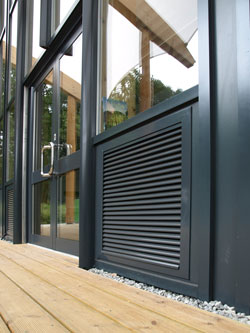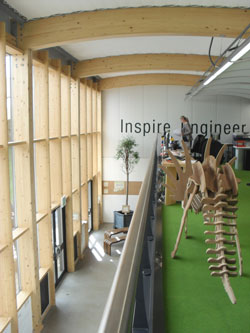Passive Approach Inspires Greenpower
Passivent showcase their project to demonstrate the practicality of developing low energy commercial and office buildings has opened its doors.

The Greenpower Centre new headquarters for Greenpower Education Trust has been developed in partnership between architects Emission Zero, Fordingbridge plc and Passivent to provide an inspiring learning environment and innovative test bed for low emission technologies. The building itself demonstrates the concept, having achieved the best A rating for energy performance.
Using innovative ventilation technology pioneered by Passivent is a key element of the energy efficiency, combining two types of passive (natural) ventilation, one for the building’s open office and lecture area and also an iMEV system for the toilets. The former is managed by a state-of-the-art control system, which also operates the air sourced heat pumps and enables occupants to change the settings via the integral web browsing facility.
The ventilation strategy harnesses the passive stack principle, whereby warm air rises, pulling in cooler air behind it. The two-storey high building’s front façade is constructed almost entirely of glass. Passivent Aircool ventilation louvres set into the façade at low level combine with Passivent Airstract terminals on the green roof to implement the ventilation.
The Aircools supply cooler external air into the building. The Airstracts act like chimneys, drawing the warm, ‘used’ internal air upwards and outwards, creating planned air paths for the fresher air to circulate through the building’s open office and lecture areas. To further enhance the internal environment, the Airstracts have been acoustically treated to minimize noise penetration from the adjacent busy A27 trunk road.
Both Aircools and Airstracts are linked to Passivent’s advanced iC7000 control system. The controller constantly monitors air quality and temperature, adjusting airflow to maintain the desired ambient warmth and CO2 levels within whilst allowing temporary or permanent over-ride to suit needs. It can also enable cool air to enter the building in warmer periods, and provide night cooling- essential because of solar gain through the high proportion of glazing.
In the toilets, Passivent ‘s ‘intelligent’ iMEV system integrates ‘intelligent’ extracts and an ‘intelligent’ fan within a central extract system. The extracts open and close in response to varying humidity levels. The central fan is constantly monitoring the extracted air and as it detects the humidity content is more than a pre-set level, it boosts the extraction rate. As the extract will be open only in a room with a high level of humidity, boosted extraction will only take place in that room. The system works without any occupier input, and ensures the interior remains fresh, dry and odour- and condensation-free 24/7, even when the building is unoccupied.
Neil Rideout, Passivent joint managing director, observes, “We have worked with Greenpower for some years, helping encourage its promotion of sustainable engineering and design and supporting its youth programme of developing and competing electrically-powered cars.
“The new headquarters aims to inspire and encapsulate Greenpower’s objectives to provide an inspiring learning environment and testbed for low emission technologies; our focus on harnessing natural resources such as air movement and daylight in construction sits logically alongside.”
Natural ventilation is proven to reduce capital costs by 15%, operating costs by 50%, and almost eliminate maintenance costs, over conventional mechanical ventilation. It is also proven to reduce incidence of “sick building syndrome” and improve the performance and productivity of the building occupiers.

Aircool ventilators are installed in the building façade to provide controlled fresh air intake or extract as part of a natural ventilation system, or in conjunction with mechanical cooling systems where they can reduce the need for daytime cooling and air conditioning. Using just 2watts of electricity to operate the ventilation louvres, the Aircool units can be minutely adjusted to control airflow requirements taking into account the weather outside- the speed and direction of wind, rain, temperature, and the location of the units within the building façade, to ensure a gentle flow of fresh air into the building without draughts. Thermally broken and insulated, the units are more thermally efficient when closed than a standard double glazed window, thanks to a controllable damper.
Passivent Airstract terminals use only natural air movement to function, with the increased pressure at higher level creating suction, drawing the warmer internal air out of the building.
Aircools, Airstracts and the iC7000 controller are just part of Passivent’s comprehensive range of sustainable building solutions, which encompasses natural ventilation, daylighting and solar control. The company, part of the Building Product Design Group, is a founder member of the NatVent EC/EU-funded project co-ordinated by the Building Research Establishment to develop practical natural ventilation solutions for the commercial sector, and has contributed to the BSRIA guide BG2/2005 Wind Driven Natural Ventilation Systems, as well as being members of the DCSF steering committee on ventilation guidance for schools, Building Bulletin 101.
Ends
